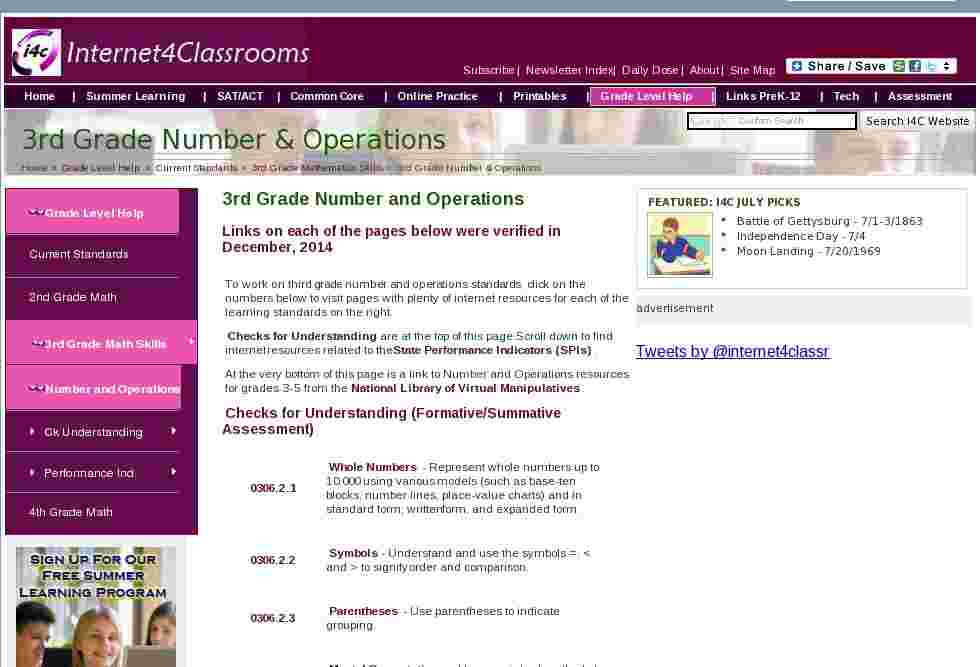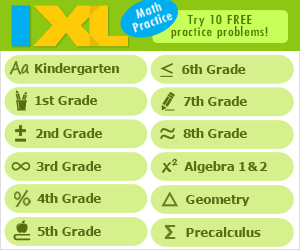3rd Grade Number and Operations
Links on each of the pages below were verified in December, 2014
To work on third grade number and operations standards, click on the numbers below to visit pages with plenty of internet resources for each of the learning standards on the right.
Checks for Understanding are at the top of this page. Scroll down to find internet resources related to the State Performance Indicators (SPIs).
At the very bottom of this page is a link to Number and Operations resources for grades 3-5 from the National Library of Virtual Manipulatives.
Checks for Understanding (Formative/Summative Assessment)
Whole Numbers - Represent whole numbers up to 10,000 using various models (such as base-ten blocks, number lines, place-value charts) and in standard form, written form, and expanded form.
Symbols - Understand and use the symbols =, < and > to signify order and comparison.
Parentheses - Use parentheses to indicate grouping.
Mental Computations - Use a variety of methods to perform mental computations and compare the efficiency of those methods.
Simple Estimates - Use highest order value (such as tens or hundreds digit) to make simple estimates.
Story Problems - Solve a variety of addition and subtraction story problems including those with irrelevant information.
Multiplications - Represent multiplication using various representations such as equal-size groups, arrays, area models, and equal jumps on number lines.
Division - Represent division using various representations such as successive subtraction, the number of equal jumps, partitioning, and sharing.
Contexts for Facts - Describe contexts for multiplication and division facts.
Unit Fractions - Understand that symbols such as 1/2, 1/3, and 1/4 represent numbers called unit fractions.
Identify Fractions - Identify fractions as parts of whole units, as parts of sets, as locations on number lines, and as division of two whole numbers.
Compare Fractions - Compare fractions using drawings, concrete objects, and benchmark fractions.
Sum of Parts - Understand that when a whole is divided into equal parts to create unit fractions, the sum of all the parts adds up to one.
State Performance Indicators
Read and Write Numbers - Read and write numbers up to 10,000 in numerals and up to 1,000 in words.
Place Value - Identify the place value of numbers in the ten-thousands, thousands, hundreds, tens, and ones positions.
Expanded Numbers - Convert between expanded and standard form with whole numbers to 10,000.
Order Numbers - Compare and order numbers up to 10,000 using the words less than, greater than, and equal to, and the symbols <, >, =.
Multiplication and Division Representations - Identify various representations of multiplication and division.
Multiplication Facts - Recall basic multiplication facts through 10 times10 and the related division facts.
Multiplication Problems - Compute multiplication problems that involve multiples of ten using basic number facts.
Inverse Relationship - Solve problems that involve the inverse relationship between multiplication and division.
Contextual Problems - Solve contextual problems involving the addition (with and without regrouping) and subtraction (with and without regrouping) of two- and three digit whole numbers.
Equivalent Fractions - Identify equivalent fractions given by various representations.
Fractions Interpretations - Recognize and use different interpretations of fractions.
Name Fractions - Name fractions in various contexts that are less than, equal to, or greater than one.
Order Fractions - Recognize, compare, and order fractions (benchmark fractions, common numerators, or common denominators).
Add and Subtract Fractions - Add and subtract fractions with like denominators.
National Library of Virtual Manipulatives
Number & Operations - for Grades 3 through 5.

Search Internet4Classrooms







